
Thomas Horwood (1600-1658) of Barnstaple in Devon, was twice Mayor of Barnstaple, in 1640 and 1653. [1] He founded an almshouse in Church Lane, Barnstaple. His mural monument survives in St Peter's Church, Barnstaple.

Thomas Horwood (1600-1658) of Barnstaple in Devon, was twice Mayor of Barnstaple, in 1640 and 1653. [1] He founded an almshouse in Church Lane, Barnstaple. His mural monument survives in St Peter's Church, Barnstaple.


He married a certain Alice, whose family is unknown, but whose paternal arms as shown on her husband's mural monument in St Peter's Church, Barnstaple were: Or, on a fesse between three martlets gules as many bezants an annulet for difference . [3] In 1659, early in her widowhood, she founded a free school for "twenty poor maids", in Church Lane, Barnstaple, next to her husband's almshouse and today in use as a coffee-shop. A slate tablet affixed in 1917 above the entrance door of Alice Horwood's School, now the "Old School Coffee Shop" in Church Lane, Barnstaple, is inscribed: "A.H. 1659. This school for 20 poor maids was founded and built by Alice Horwood. Restored 1917", and shows the arms of Horwood: Azure, a chevron ermine between three moorcocks passant argent winged sable wattled gules in chief a mullet argent for difference. Adjoining Thomas Horwood's almshouse are "Paige's Almshouses", founded by his sister Elizabeth Horwood (Mrs Paige), sister-in-law of Gilbert I Paige (d.1647), twice Mayor of Barnstaple in 1629 and 1641.

He founded an almshouse in Church Lane, Barnstaple. A contemporary tablet above the front door survives inscribed as follows:

His mural monument which survives in St Peter's Church, Barnstaple, shows an effigy of the deceased seated under an arch, his right elbow propping up his head and his left hand holding a human skull, in the vanitas genre. In the spandrels of the arch are depicted female personifications of Prudentia (left) with her attributes of mirror and snake, and Justitia (right) with her balance and sword. It includes two tablets, the higher of which is inscribed as follows:
The lower tablet is inscribed with the following verse: [5]

Edward Chichester, 1st Viscount Chichester of Eggesford in Devon, was Governor of Carrickfergus and Lord High Admiral of Lough Neagh, in Ireland.

Knowstone is a village and civil parish situated in the North Devon district of Devon, England, halfway between the Mid Devon town of Tiverton, Devon and the North Devon town of South Molton. The hamlet of East Knowstone lies due east of the village. Knowstone was the birthplace of Admiral Sir John Berry (1635–1691), second son of Rev. Daniel Berry (1609–1654), vicar of Knowstone cum Molland. An elaborate mural monument erected by Sir John in 1684 to the memory of his parents survives in Molland Church.
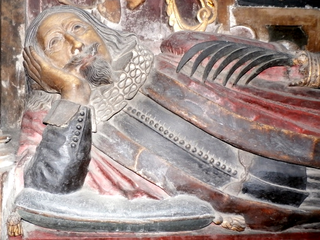
Richard Ferris was a wealthy merchant from Barnstaple in Devon, England who served as a Member of Parliament for Barnstaple in 1640 and served twice as Mayor of Barnstaple in 1632 and 1646. He founded the Barnstaple Grammar School, otherwise known as the "Blue School".

Hall is a large estate within the parish and former manor of Bishop's Tawton, Devon. It was for several centuries the seat of a younger branch of the prominent and ancient North Devon family of Chichester of Raleigh, near Barnstaple. The mansion house is situated about 2 miles south-east of the village of Bishop's Tawton and 4 miles south-east of Barnstaple, and sits on a south facing slope of the valley of the River Taw, overlooking the river towards the village of Atherington. The house and about 2,500 acres of surrounding land continues today to be owned and occupied by descendants, via a female line, of the Chichester family. The present Grade II* listed neo-Jacobean house was built by Robert Chichester between 1844 and 1847 and replaced an earlier building. Near the house to the south at the crossroads of Herner the Chichester family erected in the 1880s a private chapel of ease which contains mediaeval woodwork saved from the demolished Old Guildhall in Barnstaple.

Richard Stevens (1702–1776) of Winscott in the parish of Peters Marland, Devon, was Member of Parliament for Callington in Cornwall (1761–1768).
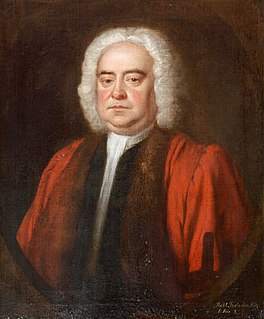
Robert Incledon (1676–1758) of Pilton House, Pilton, near Barnstaple in North Devon, was a lawyer of New Inn, London, a Clerk of the Peace for Devon, Deputy Recorder of Barnstaple and was twice Mayor of Barnstaple, in 1712 and 1721. In 1713 as mayor he supervised the building of the Mercantile Exchange on Barnstaple Quay, as recorded on the building by a contemporary brass plaque and sculpture of his armorials. He built Pilton House in 1746.
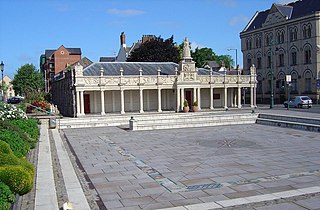
Queen Anne's Walk is a grade I listed building in the town of Barnstaple, North Devon, completed in 1713 as a meeting place for the town's merchants. It is believed to have been designed by the architect William Talman, on the basis of its similarity to his work at the Hall in Drayton, Northamptonshire. It was promoted and financed by the thirteen members of the Corporation of Barnstaple whose armorials are sculpted on and above the parapet, and the work was overseen by Robert Incledon (1676–1758), Mayor of Barnstaple in 1712–13. It has been owned for many decades by North Devon District Council, which currently (2014) leases it to Barnstaple Town Council, and now trades as The Cafe on the Strand.

St Peter's Church is the parish church of the town of Barnstaple in North Devon, England. Parts of the church date to the 13th-century with much restoration during the Victorian era by George Gilbert Scott and later by his son John Oldrid Scott which changed the atmosphere of the building, although many fine wall monuments and tablets remain. The church comes under the Diocese of Exeter.

The Dodderidgian Library was founded in 1667 in Barnstaple, North Devon, England, by Judith Dodderidge, third wife and widow of John Dodderidge (1610–1659) of Barnstaple and Bremridge, South Molton, MP. It represents one of the earliest town libraries in England which continues in existence since its foundation.

Richard Beaple of Barnstaple, Devon, was a wealthy merchant, ship owner and member of the Spanish Company, and was three times Mayor of Barnstaple in 1607, 1621 and 1635. His elaborate mural monument survives in St Peter's Church, Barnstaple.
The Manor of Clovelly is a historic manor in North Devon, England. Within the manor are situated the manor house known as Clovelly Court, the parish church of All Saints, and the famous picturesque fishing village of Clovelly. The parish church is unusually well-filled with well-preserved monuments to the lords of the manor, of the families of Cary, Hamlyn, Fane, Manners and Asquith. In 2015 the Rous family, direct descendants via several female lines of Zachary Hamlyn (1677–1759) the only purchaser of Clovelly since the 14th century, still own the estate or former manor, amounting to about 2,000 acres, including Clovelly Court and the advowson of the parish church, and the village of Clovelly, run as a major tourist attraction with annual paying visitor numbers of about 200,000.
James Smith of Hammersmith, Middlesex, was an Alderman of the City of London a member of the Worshipful Company of Salters and a Governor of Christ's Hospital in London. His monument survives in St Paul's Church, Hammersmith. He was the grandfather of Sir John Smith, 1st Baronet, of Isleworth.

Hugh Squier (1625-1710) of Petty France, Westminster, was a wealthy merchant best remembered as a generous benefactor to the town of South Molton in Devon, the place of his birth, where in 1684 he founded a "free school".

Gilbert Paige of Crock Street, Barnstaple, and Rookabeare House in the adjoining parish of Fremington, Devon, was a merchant who was twice Mayor of Barnstaple in 1629 and 1641.

Christopher Lethbridge of Exeter in Devon, was Mayor of Exeter in 1660, and is one of the Worthies of Devon of the biographer John Prince, (1643–1723). His mural monument survives in St Mary Arches Church in Exeter.
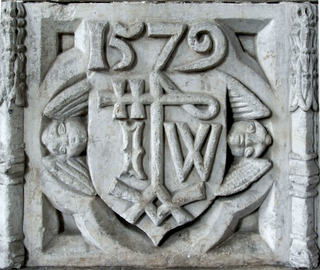
John Waldron of Tiverton in Devon, England, was a wealthy merchant who founded and endowed the surviving grade II* listed "Waldron's Almshouses" and Chapel on the outskirts of Tiverton. His elaborately sculpted chest tomb survives in St Peter's Church, Tiverton, at the east end of the south aisle, still in an entirely Gothic style with a Gothic black-letter inscription on the ledger stone on top, and showing on the base Gothic pinnacled niches and within quatrefoils escutcheons displaying his merchant's mark. His name is sometimes confused with "Walrond" a prominent and ancient gentry family long seated at Bradfield House in the parish of Uffculme, Devon, about 6 miles east of Tiverton. The spelling "Waldron" is clearly shown incised in Gothic letters on the ledger stone on top of his chest tomb.

George Peard (1548–1621) of the High Street, Barnstaple in north Devon, England was a lawyer of that town and was twice elected as one of the two Members of Parliament for Barnstaple, in 1597 and 1604.
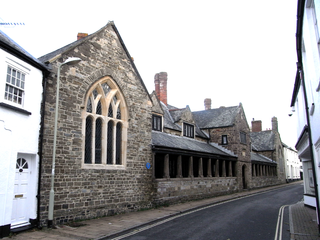
Penrose's Almshouses are 17th-century almshouses in Litchdon Street, Barnstaple, in Devon, England, built in memory of John Penrose (1575–1624), a merchant and Mayor of Barnstaple. They have been a Grade I listed building since 1951.

Rev. Martin Blake (1593-1673) was vicar of Barnstaple in Devon, 1628–56; 1660–73, and suffered much for his adherence to the Royalist cause during the Civil War, as related in John Walker's Sufferings of the Clergy (1714). According to Chanter (1882) "The eventful history of the Rev. Martin Blake has been often written in public history and local annals".
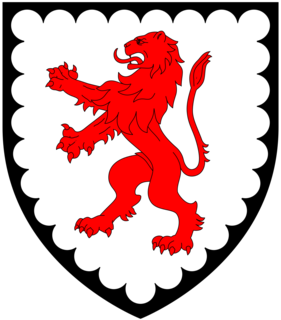
Arthur Champneys of Raleigh House in the parish of Pilton, Devon, and of Love Lane in the City of London, England, was a wealthy merchant and a Member of Parliament for Barnstaple, in Devon, from 1690 to 1705.